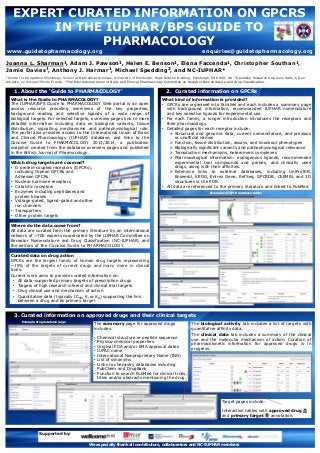GPCRs in the Guide to PHARMACOLOGY poster
Poster presented at the GPCR Barcelona Spring meeting of the GLISTEN network April 28-29th 2014 (abstract below). G protein-coupled receptors (GPCRs) are the largest family of human drug targets representing ~19% of the targets of current drugs and many more in clinical trials [1]. We have developed the IUPHAR/BPS Guide to PHARMACOLOGY portal (the new home of the IUPHAR Database) to provide free access to curated information on important pharmacological targets and the substances that act on them [2]. The database includes data on 394 GPCRs including 130 “orphans” without confirmed endogenous ligands. This includes the recent addition of 33 adhesion class GPCRs. Development of the database is overseen by the International Union of Basic and Clinical Pharmacology (IUPHAR) Committee on Receptor Nomenclature and Drug Classification (NC-IUPHAR). Expert subcommittees for each GPCR family provide recommendations on receptor nomenclature and peer-reviewed summaries of the literature covering properties such as function, pharmacology, signalling mechanism, important variants, available assay systems and mouse knockout phenotypes. Ligands are annotated with their chemical structures, or sequences and post-translational modifications for peptides. Links are provided to other online databases including GPCRDB, UniProt, Ensembl and PubChem. Current work includes identifying the mechanism of action for approved drugs treating human diseases, mapping them to their primary targets and curating supporting data in the literature (e.g. Ki, Kd, IC50). In some cases we also annotate data-supported polypharmacology where interactions of comparable in vitro potencies against multiple targets have been published. The database is available online at http://www.guidetopharmacology.org. 1. Rask-Andersen M, Masuram S, Schiöth HB. (2014) The druggable genome: evaluation of drug targets in clinical trials suggests major shifts in molecular class and indication. Annu Rev Pharmacol Toxicol., 54: 9-26. 2. Pawson AJ, Sharman JL, Benson HE et al. (2014) The IUPHAR/BPS Guide to PHARMACOLOGY: an expert-driven knowledgebase of drug targets and their ligands. Nucl. Acids Res., 42 (Database Issue): D1098-106.

Recommended
Recommended
More Related Content
More from Guide to PHARMACOLOGY
More from Guide to PHARMACOLOGY (20)
Recently uploaded
Recently uploaded (20)
GPCRs in the Guide to PHARMACOLOGY poster
- 1. Joanna L. Sharman1, Adam J. Pawson1, Helen E. Benson1, Elena Faccenda1, Christopher Southan1, Jamie Davies1, Anthony J. Harmar1, Michael Spedding2, and NC-IUPHAR* 1Centre for Integrative Physiology, School of Biomedical Sciences, University of Edinburgh, Hugh Robson Building, Edinburgh, EH8 9XD, UK. 2Spedding Research Solutions SARL, 6 Rue Ampere, Le Vésinet 78110, France. *The International Union of Basic and Clinical Pharmacology Committee on Receptor Nomenclature and Drug Classification. www.guidetopharmacology.org EXPERT CURATED INFORMATION ON GPCRS IN THE IUPHAR/BPS GUIDE TO PHARMACOLOGY enquiries@guidetopharmacology.org 2. Curated information on GPCRs What kind of information is provided? • GPCRs are organised into families and each includes a summary page with background information, recommended IUPHAR nomenclature and key selective ligands for experimental use. • For each family, a longer introduction introduces the receptors and their pharmacology. • Detailed pages for each receptor include: Structural and genomic data, current nomenclature, and previous or unofficial names Function, tissue distribution, assays, and knockout phenotypes Biologically significant variants and pathophysiological relevance Transduction mechanisms, heteromeric complexes Pharmacological information: endogenous ligands, recommended experimental tool compounds and probes, and clinically used drugs, along with their affinities. Extensive links to external databases, including UniProtKB, Ensembl, KEGG, Entrez Gene, RefSeq, GPCRDB, ChEMBL and 3D structures in the PDB. • All data are referenced to the primary literature and linked to PubMed. Examples of GPCR database tables 1. About the ‘Guide to PHARMACOLOGY’ What is the Guide to PHARMACOLOGY? The IUPHAR/BPS Guide to PHARMACOLOGY Web portal is an open access resource providing overviews of the key properties, background reading and selective ligands of a wide range of biological targets. For selected targets, overview pages link to more detailed information including data on biological variants, tissue distribution, signalling mechanisms and pathophysiological role. The portal also provides access to the International Union of Basic and Clinical Pharmacology (IUPHAR) database, and links to the Concise Guide to PHARMACOLOGY 2013/2014, a publication snapshot created from the database overview pages and published in the British Journal of Pharmacology. Which drug targets are covered? • G protein-coupled receptors (GPCRs), including Orphan GPCRs and Adhesion GPCRs • Nuclear hormone receptors • Catalytic receptors • Enzymes including peptidases and protein kinases • Voltage-gated, ligand-gated and other ion channels • Transporters • Other protein targets Where do the data come from? All data are curated from the primary literature by an international network of >700 experts coordinated by the IUPHAR Committee on Receptor Nomenclature and Drug Classification (NC-IUPHAR) and the editors of the Concise Guide to PHARMACOLOGY. Curated data on drug action GPCRs are the largest family of human drug targets representing ~19% of the targets of current drugs and many more in clinical trials. Current work aims to provide curated information on: • All data-supported primary targets of prescription drugs • Targets of high research interest and clinical trial targets • Drug clinical use and mechanism of action • Quantitative data (typically IC50, Ki or Kd) supporting the link between a drug and its primary target We especially thank all contributors, collaborators and NC-IUPHAR members Supported by: 3. Curated information on approved drugs and their clinical targets Example drug database page The summary page for approved drugs includes: • Chemical structure or peptide sequence • Physico-chemical properties • Original FDA and/or EMA approval dates • IUPAC name • International Nonproprietary Name (INN) • List of synonyms • Links to chemistry databases including PubChem and DrugBank • Function to search PubMed for clinical trials, titles and/or abstracts mentioning the drug The biological activity tab includes a list of targets with quantitative affinity data. The clinical data tab includes a summary of the clinical use and the molecular mechanism of action. Curation of pharmacokinetic information for approved drugs is in progress. Target pages include: Interaction tables with approved drug and primary target annotation.
